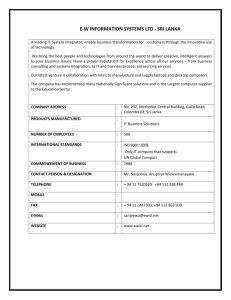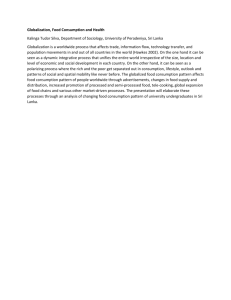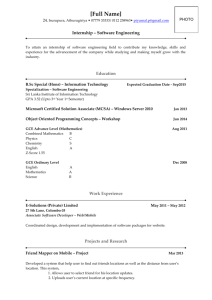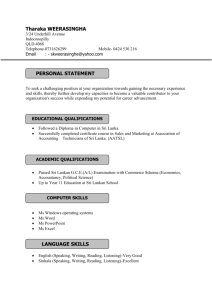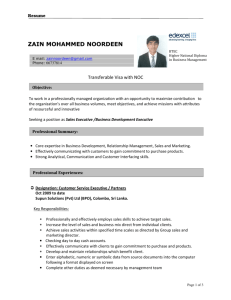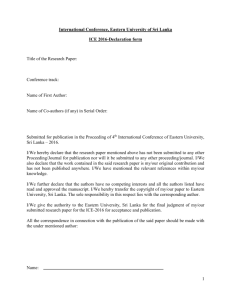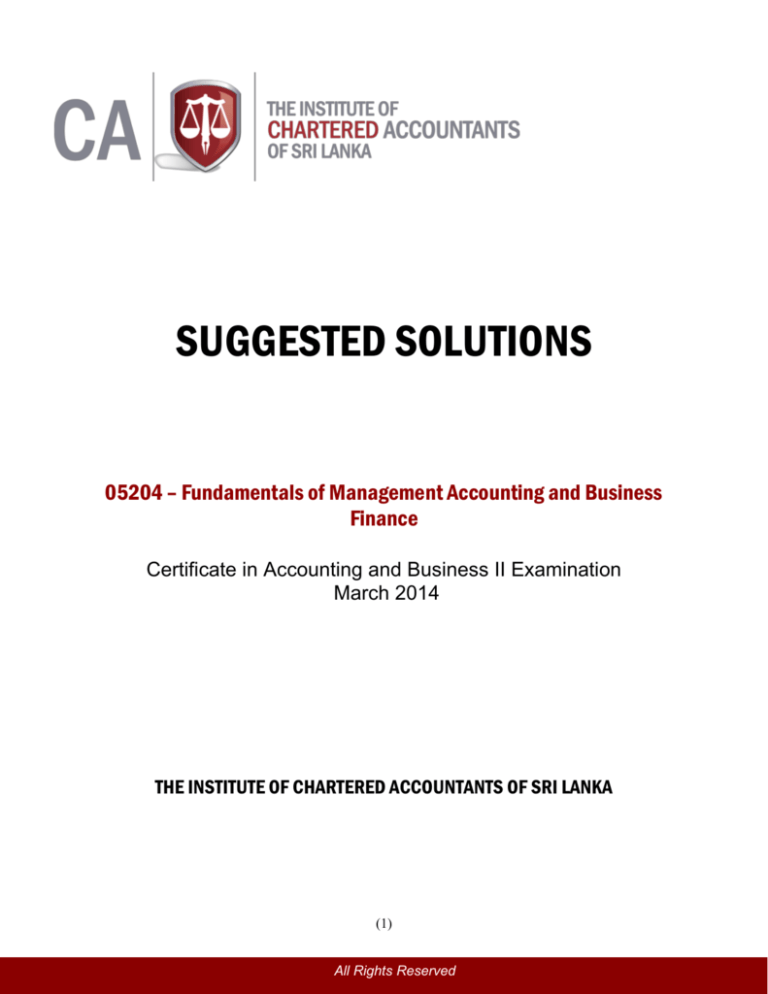
SUGGESTED SOLUTIONS
05204 – Fundamentals of Management Accounting and Business
Finance
Certificate in Accounting and Business II Examination
March 2014
THE INSTITUTE OF CHARTERED ACCOUNTANTS OF SRI LANKA
(1)
All Rights Reserved
Answer No. 01
(a)
(i)
Sales budget (Rs) - 2014/15
Product
Units
Selling
Price
Total Revenue
Standard
Deluxe
50,000
10,000
6,000
8,000
300,000,000
80,000,000
380,000,000
(ii)
Production budget (quantity) - 2014/15
Budgeted sales
Add: Target ending finished goods inventory
Less: Beginning finished goods inventory
Budgeted production
Standard
50,000
11,000
61,000
(1,000)
60,000
Deluxe
10,000
500
10,500
(500)
10,000
(iii) Direct material usage budget (in quantity and value) - 2014/15
(In quantity)
Treated
rubber
(Boards)
Glass
(Sq. Ft)
Requirement for 60,000 standard tables
Requirement for 10,000 deluxe tables
Total usage
720,000
120,000
840,000
360,000
80,000
440,000
(In value)
Cost per unit
Value of total usage
(2)
Rs
70
Rs
100
58,800,000
44,000,000
Total
Rs
102,800,000
(iv) Direct material purchases budget (in quantity and value) - 2014/15
Treated rubber
(Boards)
Glass
(Sq. Ft)
Usage for production
Add: target ending inventory
840,000
80,000
440,000
20,000
Total requirement
Less: beginning inventory
920,000
(70,000)
460,000
(60,000)
Quantity to be purchased
850,000
400,000
(In quantity)
(In value)
Rs
70
Cost per unit
Value of total purchases
Rs
100
59,500,000
40,000,000
Total
Rs
9,500,000
(v) Direct manufacturing labour cost budget - 2014/15
Quantity to be produced
Direct labour hours per unit
Total hours required
Labour rate per hour
Total labour cost (Rs)
Standard
60,000
Deluxe
10,000
4
240,000
6
60,000
Total
300,000
200
60,000,000
(b) Overhead absorption rates
(i) Manufacturing overheads (other than machine set up overhead)
Total
90,000,000
Total overhead cost (Rs)
Total direct manufacturing labour hours
Overhead cost per labour hour (Rs.)
300,000
300
Direct labour hours per unit
Overhead cost to be absorbed per unit
(Rs.)
(3)
Standard
Deluxe
4
1,200
6
1,800
(ii)
Machine set up overheads
Quantity to be produced
Batch size
Number of batches
Set up time - Labour hours per batch
Total set up time (hours)
Standard
Deluxe
60,000
10,000
50
40
1,200
250
10
12
12,000
3,000
Total machine set up overheads (Rs)
Total
15,000
30,000,000
Machine set up overheads per hour (Rs)
2,000
Machine set up overhead per batch (Rs)
Machine set up overhead per unit (Rs)
20,000
24,000
400
600
(c) Manufacturing cost per unit (Rs)
Treated rubbber (70 x 12)
Standard (St)
840
Deluxe (De)
840
600
800
800
1,200
400
3,840
1,200
1,800
600
5,240
Glass (St: 100x6 and De: 100x8)
Direct manufacturing labour (St: 200x4
and De: 200x6)
Direct manufacturing overhead
Machine set up overhead
Manufacturing cost per unit
(d) Ending inventory budget
Quantity
Cost per
unit (Rs)
80,000
70
5,600,000
Glass (Sq. ft.)
20,000
100
2,000,000
7,600,000
Finished goods
Standard (units)
Deluxe (units)
11,000
500
3,840
5,240
42,240,000
2,620,000
44,860,000
Direct material
Treated rubber (boards)
Total ending inventory
Total Cost (Rs)
52,460,000
(4)
Cost of goods sold budget
Rs
Direct material used
Direct manufacturing labour
Manufacturing overheads (90m + 30m)
Beginning inventory of finished goods
Ending inventory of finished goods
6,460,000
(44,860,000)
(38,400,000)
244,400,000
Cost of goods sold
OR
Rs
102,800,000
60,000,000
120,000,000
282,800,000
Standard
Deluxe
Sales
Qty
Std cost
50,000
10,000
3,840
5,240
(5)
Cost of sales
(Rs)
192,000,000
52,400,000
244,400,000
Answer No. 02
(a)
Selling price per unit
Variable manufacturing cost per unit
Variable marketing cost per unit
Contribution margin per unit
Number of regular machine hours
Contribution margin per machine hour (Rs)
Don
Rs
1,000
(600)
(150)
250
1.0
250
Key
Rs
1,500
(1,000)
(350)
150
0.5
300
Note 1 : Please note that for Option I and option II below, contribution margin on 10,000 units
of Don for the committed order, can be ignored since it is common for either option. In that
sense, the relevant benefit of Option 1 would be Rs. 9 million and that of Option 2 would be Rs.
10 million.
Option 1: Based on the ranking above, if preference is given to production of Key, then 10,000
units of Don (minimum requirement) and 80,000 units of Key (balance 40,000 hours / 0.5) should
be produced.
The result will be as follows:
Contribution margin on 10,000 Don (250 x 10,000)
Contribution margin on 80,000 Key (150 x 80,000)
Total contribution margin
Lease cost of high precision machine
Net relevant benefit
Rs
2,500,000
12,000,000
14,500,000
(3,000,000)
11,500,000
Option 2 : If all the regular machine hours are used to produce Don instead, 50,000
units can be produced. The result will be as follows:
Contribution margin / Net relevant benefit (250 x 50,000)
Rs
12,500,000
Even though Key has the higher contribution margin per machine hour, due to the lease cost
of the high precision machine, the relevant operating profit generated from the first product
mix is less than what could be derived by producing only Don.
Therefore, the operating profit is maximised when Don is produced using the
regular machine hours entirely. Hence 50,000 units of Don should be produced.
(6)
(b)
Based on the ranking, if preference is given to production of Key, then 10,000 units of Don
(minimum requirement) and 130,000 units of Key (balance 65,000 hours / 0.5) should be
produced.
The result will be as follows:
Contribution margin on 10,000 Don (250 x 10,000)
Contribution margin on 130,000 Key (150 x 130,000)
Rs
2,500,000
19,500,000
Total contribution margin
Incremental cost of enhancing capacity
Lease cost of high precession machine
22,000,000
(1,500,000)
(3,000,000)
Net relevant benefit
17,500,000
Instead, if all the regular machine hours are used to produce Don, 65,000 units can be produced.
The result will be as follows:
Rs
18,750,000
(1,500,000)
Contribution margin / Net relevant benefit (250 x 65,000)
Incremental cost of enhancing capacity
17,250,000
Therefore the new product mix should be 10,000 units of Don and 130,000 units of Key.
The operating profit will increase by Rs 5,000,000 (17,500,000 - 12,500,000)
(c)
Don
Rs
Key
Rs
Bul
Rs
Selling price per unit
1,000
1,500
1,200
Variable manufacturing cost per unit
(600)
(1,000)
(700)
Variable marketing cost per unit
(150)
(350)
(150)
Contribution margin per unit
Number of regular machine hours
(hrs)
250
150
350
1.0
0.5
1.0
Contribution margin per machine hour
250
300
350
(7)
Bul would be most preferred as it has the highest contribution margin per unit of constrained
resource and does not require any additional overheads to be incurred such as lease cost of high
precision machines.
Therefore the special order should be accepted.
When the special order is accepted, 20,000 units of Bul and 10,000 units of Don will require 30,000
regular machine hours, leaving 45,000 machine hours for Don or Key
If Key is made using all 45,000 hours, the operating profit will be 45,000 x 300 - 3,000,000 = Rs.
10,500,000.
If Don is made using all 45,000 hours, the operating profit will be 45,000 x 250 = Rs. 11,250,000
Therefore 45,000 units of Don should be produced using the balance machine hours.
Accordingly, the product mix and profits would be as follows
55,000
20,000
units of Don
55,000 x 250
units of Bul
20,000 x 350
Total contribution
Capacity enhancement cost
Operating profit
(8)
Rs
13,750,000
7,000,000
20,750,000
(1,500,000)
19,250,000
Answer No. 03
(a)
The payback period method measures the period in which the total investment could be fully
recovered. For this, both undiscounted and discounted cash flows can be used.
This method has the following drawbacks:
♦
It ignores cash flows earned after the payback period
♦
Undiscounted payback period does not consider time value of money, it can recommend
a negative NPV project
♦
It could give incorrect ranking when evaluating projects
It does not give the amount of the profitability of the
♦
project
However, in the following situations, the payback method is
frequently used:
♦
♦
♦
♦
♦
When ranking projects where a firm has liquidity constraints and require fast repayment
of capital
When evaluating risky investments in uncertain markets with fast design and product
changes
When future cash flows are extremely difficult to predict
In conjunction with other appraisal
techniques
Since it is easily understood by all levels of management
(b)
Year 0
Year 1
Year 2
Year 3
Year 4
Rs. '000
Year 5
(50,000)
-
(1,000)
(1,000)
(1,000)
(1,000)
5,000
(1,000)
(5,000)
-
-
-
-
-
Lost revenue from forklift
-
(1,200)
(1,200)
(1,200)
(1,200)
(1,200)
Saving on rent (W1)
-
41,800
7,800
7,800
7,800
7,800
Saving on security
-
600
600
600
600
600
Saving on transport
-
1,300
1,300
1,300
1,300
1,300
Saving on travelling
-
100
100
100
100
100
(55,000)
41,600
7,600
7,600
7,600
12,600
1.000
0.870
0.756
0.658
0.572
0.497
(55,000)
2,548
36,192
5,746
5,001
4,347
6,262
Cash flows
Mezzanine floor
Floor maintenance
Pallet trucks
Net cash flow
DF (@15%)
DCF
NPV
Since NPV is positive it is recommended to invest in the Mezzanine Floor.
(9)
Working 1 (W1)
Year 1
Year 2
Year 3
Year 4
Year 5
Rent for the relevant years
15,600
15,600
15,600
15,600
15,600
Advance paid (50%)
(7,800)
(7,800)
(7,800)
(7,800)
(7,800)
Refund of the advance rent
39,000
-
-
-
-
Agreement cancellation fees
(5,000)
Rent savings
41,800
7,800
7,800
_7,800
7,800
♦ Scrap value of the forklift is not an incremental revenue since it was an existing machine
♦ Old salary of security personnel is not relevant
♦ Consultant's fee is committed/sunk, therefore not relevant
♦ Existing handling workers' salary is not an incremental/avoidable cost
♦ Stores manager's salary is not an incremental/avoidable revenue
Alternate Answer
PV of cash outflows from Mezzanine Floor
Cash flows
Year 00
Mezzanine floor
(50,000)
Floor maintenance
Pallet
trucks
Year 01
Year 02
Year 03
Year 04
Year 05
5,000
-
(1,000)
(5,000)
(1,000)
-
-
(5,000)
(1,000)
(1,000)
(1,000)
-
-
-
-
-
-
-
-
Ag. Cancellation fee
Net cash
flow
DF (@
15%)
(55,000)
(6,000)
(1,000)
(1,000)
(1,000)
4,000
1.000
0.870
0.756
0.658
0.572
0.497
DCF
(55,000)
(5,220)
(756)
(658)
(572)
1,988
NPV
(60,218)
(10)
Alternate Answer
PV of cash outflows from Mezzanine Floor
Cash flows
Year 00
Mezzanine floor
(50,000)
Floor maintenance
Pallet trucks
Ag. Cancellation fee
Year 01
Year 02
Year 03
Year 04
Year 05
5,000
(5,000)
-
(1,000)
(5,000)
(1,000)
-
(1,000)
-
(1,000)
-
(1,000)
-
(55,000)
(6,000)
(1,000)
(1,000)
(1,000)
4,000
1.000
0.870
0.756
0.658
0.572
0.497
DCF
(55,000)
(5,220)
(756)
(658)
(572)
1,988
NPV
(60,218)
Net cash flow
DF (@ 15%)
PV of cash outflows relating to Present External
Warehouse
Year 1
Year 2
Year 3
Year 4
Year 5
-
1,200
1,200
1,200
1,200
1,200
Security expenses
-
(600)
(600)
(600)
(600)
(600)
Transport expenses
-
(1,300)
(1,300)
(1,300)
(1,300)
(1,300)
Travelling
-
(100)
(100)
(100)
(100)
(100)
Rent expenses
-
(46,800)
(7,800)
(7,800)
(7,800)
(7,800)
Net cash flow
-
(47,600)
(8,600)
(8,600)
(8,600)
(8,600)
0.870
0.756
0.658
0.572
0.497
(41,412)
(6,502)
(5,659)
(4,919)
(4,274)
Cash flows
Revenue from
forklift
DF (@ 15%)
Year 0
1.000
DCF
NPV
(62,766)
(11)
Answer No. 04
(a)
According to the present system
Material cost
Labour cost
Manufacturing overheads
Rs
64,474,000
6,000,000
5,000,000
Total joint cost
Less: Sales of by-product
75,474,000
(474,000)
Net joint cost
Total output
Cost per unit
75,000,000
300,000
250.00
Selling price
Output (units)
Sales
(b)
Product A
Product B
Product C
275.00
158,000
43,450,000
425.00
94,800
40,290,000
520.00
47,200
24,544,000
Total sales
108,284,000
Total cost
(75,000,000)
Net profit
33,284,000
Output of Product A for the past six months
Expected output of Product E
Selling price of Product E per kg
Additional sales generated from sale of Product E
Loss of sale of Product A
Additional variable cost of further processing
Additional fixed cost of further processing (0.2 million * 6 months)
Net loss to the company
158,000
150,100
330
49,533,000
(43,450,000)
(7,505,000)
(1,200,000)
(2,622,000)
Since further processing generates a loss of Rs. 2.622 million, the management’s decision
not to further process Product A is a valid decision.
(c)
♦
♦
♦
Sales prices of the chemicals are not at the same level
The cost should be apportioned on the benefit received from each chemical
The weight method is simple but it ignores the realisable value (benefit) of chemicals
Therefore, the most suitable method in this situation is the sales
value method
(12)
(d)
Total joint cost after deducting sales of by product
Sales at split off point
(Rs.)
Product A
Product B
Product C
Cost allocation
(Rs.)
43,450,000.00
40,290,000.00
24,544,000.00
108,284,000.00
30,094,473.79
27,905,784.79
16,999,741.42
75,000,000.00
(e)
Current price per kg of Product E
Duty per kg
Possible minimum price per kg in the market
Additional sales from Product E (430*150,100)
Total additional cost
Loss of sales of Product A
Additional benefit of further processing
75,000,000
Output
(Units)
158,000
94,800
47,200
300,000.00
Cost per unit
(Rs.)
190.47
294.36
360.16
Rs.
330.00
100.00
430.00
64,543,000
(8,705,000)
(43,450,000)
12,388,000
OR
Additional revenue due from price increases from import duty
= 100 * 150,100
15,010,000
Previous loss per part (b) above
(2,622,000)
Additional benefit of further processing
12,388,000
Since there is an additional benefit, even after taking in to account of the possible tax,
if further processing of Product E takes place, the management can be advised to
manufacture Product E in the future.
(13)
Answer No. 05
(a) (i) Fixed manufacturing overhead cost per unit = 75,000,000/3,000
= Rs. 25,000 per three-wheeler (TW)
(ii) Per unit cost (Rs)
Variable manufacturing cost
Fixed manufacturing overhead per unit
Total manufacturing cost per unit
98,000
25,000
123,000
(iii)
Number of units sold
Number of units manufactured
Increase / decrease in the inventory
Inventory at the beginning
Inventory at the end
(b)
October
November
December
2,000
3,200
1,200
1,200
2,900
2,400
(500)
1,200
700
3,200
3,800
600
700
1,300
October
November
December
Operating profit - Absorption costing (Rs '000)
Revenue @
Cost of goods sold
160
320,000
464,000
512,000
Beginning inventory @
Variable manufacturing costs @
Fixed manufacturing costs @
Cost of goods available for sale
Ending inventory @
123
98
25
313,600
80,000
393,600
(147,600)
246,000
147,600
235,200
60,000
442,800
(86,100)
356,700
86,100
372,400
95,000
553,500
(159,900)
393,600
5,000
241,000
(15,000)
371,700
20,000
373,600
79,000
395
92,300
462
138,400
692
123
Adjustment for manufacturing variances (W1)
Total cost of goods sold
Operating profit
Bonus (Rs '000) @
0.50%
(14)
(W1)
Excess / (shortage) of production
Adjustment @
October
200
5,000
25
November
(600)
(15,000)
December
800
20,000
(c) Operating profit - Marginal Costing (Rs '000)
Revenue @
Cost of goods sold
Beginning inventory @
October
November
December
160
320,000
464,000
512,000
98
-
117,600
68,600
98
313,600
313,600
117,600
196,000
235,200
352,800
68,600
284,200
372,400
441,000
127,400
313,600
124,000
75,000
49,000
179,800
75,000
104,800
198,400
75,000
123,400
_______245
_______524
_______617
November
461.50
524.00
(62.50)
December
692.00
617.00
75.00
Total
1,548.50
1,386.00
162.50
Variable manufacturing costs @
Cost of goods available for sale
Ending inventory @
Variable cost of goods sold
98
Contribution
Fixed manufacturing costs
Operating profit
Bonus (Rs '000) @
(d)
Absorption costing bonus
Marginal costing bonus
Difference
0.50%
October
395.00
245.00
150.00
The difference in the bonus under the two methods arises because of the difference in
production and sales, in other words due to variation in inventory
October
November
December
1,200
(500)
600
As per (a) (iii) Increase /
decrease in the inventory
With absorption costing, by building for inventory, the CEO can capitalise Rs 25,000 of fixed
manufacturing overhead costs per unit.
(15)
This will provide a bonus payment of Rs 125 (25,000 x 0.5%) per unit.
Operating income under absorption costing will exceed that under marginal costing when
production is greater than sales. Over the three month period, the inventory build-up is 1,300
units giving a difference of Rs 162,500 (125 x 1,300) in bonus payments.
The CEO will be benefitted by increasing the production irrespective of sales. As a
result,therefore, inventories could be built-up and inventory holding costs also might be
increased.
(16)
Answer No. 06
(a)
Direct material I (1,210,000/5,500)
Direct material II (7,040,000/5,500)
Direct labour (660,000/5,500)
Varibale overheads (412,500/5500)
Fixed production overheads (275,000/5,500)
(b)
Rs.
220.00
1,280.00
120.00
75.00
50.00
Standard cost per pack
Or:
1,745.00
9,597,500/5,500
1,745.00
Sales
Less: Opening finished goods (349,000/1745)
Add: Closing finished goods (872,500/1745)
Manufactured units
Per pack overhead absorption (as above)
Overheads for the manufactured units (5,800*50)
Less: amount over-absorbed
Budgeted fixed production overheads (Rs.)
(c) (i) Material price variance = (Std price - Act price) Act Qty purchased
5,500.00
(200.00)
500.00
5,800.00
50.00
290,000.00
(40,000.00)
250,000.00
OR
(Standard price x Actual quantity purchased) – (Actual Price x Actual Quantity purchased)
Material I = [(1,210,000/11,000)*11,300 - (1,265,600)]
(22,600)
Adverse
Material II = [(7,040,000/44,000)*46,900 - (7,504,000)]
Nil
(ii)
Favourable
Material usage variance = (Std usage - Act usage) Std price
Material I = [(11,000/5500)*5800 - 11,300)]*110
33,000
Favourable
(17)
Material II = [(44,000/5500*5800) - 46,900]*160
(80,000.00)
Adverse
(iii) Labour rate variance = (Std rate - Act rate) Act hours
= (660,000/2,750 - 650,000/2,600)*2,600
(26,000.00)
Adverse
(iv) Labour efficiency variance = (Std hours - Act hours) Std rate
= [(2,750/5,500)*5,800 - 2,600)]*240
72,000.00
(v)
Favourable
FOH expenditure variance = Btd OH - Actual OH.
= 250,000 - 280,000
(30,000.00)
(d)
Adverse
Much motivated work environment than expected
Availability of trained employees
Strong supervisory team
Incentive based productivity improvements
Higher quality of material than expected
Perfect functioning of plant and machinery than expected
Errors in set standards
(18)
Answer No. 07
(a)
(i)
Sub-division of shares
This is where a company increases its number of shares by splitting/dividing its existing shares
according to a predetermined ratio. As a result, the share price will decrease making it affordable
for the common investors to buy. The stated capital will not change as a result of subdivision.
(ii)
Rights issue
A rights issue is where the existing shareholders have the first right to subscribe to additional capital
raised by the company. In other words shares are offered to existing shareholders based on a
predetermined ratio. The value of stated capital will increase due to a rights issue.
(b)
(i)
Net Assets Value per share
31 December 2013
Shareholders' funds/no. of shares in issue (Rs.) =
36.00
After sub-division in January 2013
Subdivided in the ratio of 5:4
Therefore; (36*4)/5 =
28.80
After rights issue in February 2013
2 new shares at Rs. 24 for every 10 existing shares
Therefore: ((28.80*10)+(24*2))/12
(ii)
28.00
Initial number of shares
Subdivided 5:4
Rights issue 2:10
40.00 million
10.00 million
10.00 million
Number of shares after rights
issue
60.00 million
(19)
(iii)
(c)
Original stated capital
Rs.
1,000 million
Rights issue
Rs.
240 million
New stated capital
Rs.
1,240 million
50% of the market price before the right issue (Rs)
Market price before the rights issue (Rs.)
24.00
48.00
Before the subdivision of 5:4: (48*5/4) (Rs.)
60.00
Amalgamation, takeover etc.
Before IPO - to decide IPO
price
Fair value estimation for accounting purposes
When transferring shares from one party to another
When a loan is advanced on the security of shares, it becomes necessary to know
the value of shares on the basis of which loan has been advanced.
When preference shares or debentures are converted into equity shares, it becomes
necessary to value the equity shares for ascertaining the number of equity shares
required to be issued for debentures or preference shares which are to be converted.
(d)
PV of first five years = 3.3522*25 million (Rs.)
83.81 million
PV of FCF from Year 5 onwards = 30*6.6667*0.4972 (Rs.)
99.44 million
183.25 million
Total number of shares
40 million
Value per share (Rs.)
4.58
(20)
Notice of Disclaimer
The answers given are entirely by the Institute of Chartered Accountants of Sri Lanka (CA Sri
Lanka) and you accept the answers on an "as is" basis.
They are not intended as “Model answers’, but rather as suggested solutions.
The answers have two fundamental purposes, namely:
1.
to provide a detailed example of a suggested solution to an examination question; and
2.
to assist students with their research into the subject and to further their understanding and
appreciation of the subject.
The Institute of Chartered Accountants of Sri Lanka (CA Sri Lanka) makes no warranties with
respect to the suggested solutions and as such there should be no reason for you to bring any
grievance against the Institute of Chartered Accountants of Sri Lanka (CA Sri Lanka). However,
if you do bring any action, claim, suit, threat or demand against the Institute of Chartered
Accountants of Sri Lanka (CA Sri Lanka), and you do not substantially prevail, you shall pay the
Institute of Chartered Accountants of Sri Lanka's (CA Sri Lanka’s) entire legal fees and costs
attached to such action. In the same token, if the Institute of Chartered Accountants of Sri Lanka
(CA Sri Lanka) is forced to take legal action to enforce this right or any of its rights described
herein or under the laws of Sri Lanka, you will pay the Institute of Chartered Accountants of Sri
Lanka (CA Sri Lanka) legal fees and costs.
© 2013 by the Institute of Chartered Accountants of Sri Lanka(CA Sri Lanka).
All rights reserved. No part of this document may be reproduced or transmitted in any form or by
any means, electronic, mechanical, photocopying, recording, or otherwise, without prior written
permission of the Institute of Chartered Accountants of Sri Lanka (CA Sri Lanka).
(21)
05204 – Fundamentals of Management Accounting and Business Finance :
Certificate in Accounting and Business II Examination
March 2014

